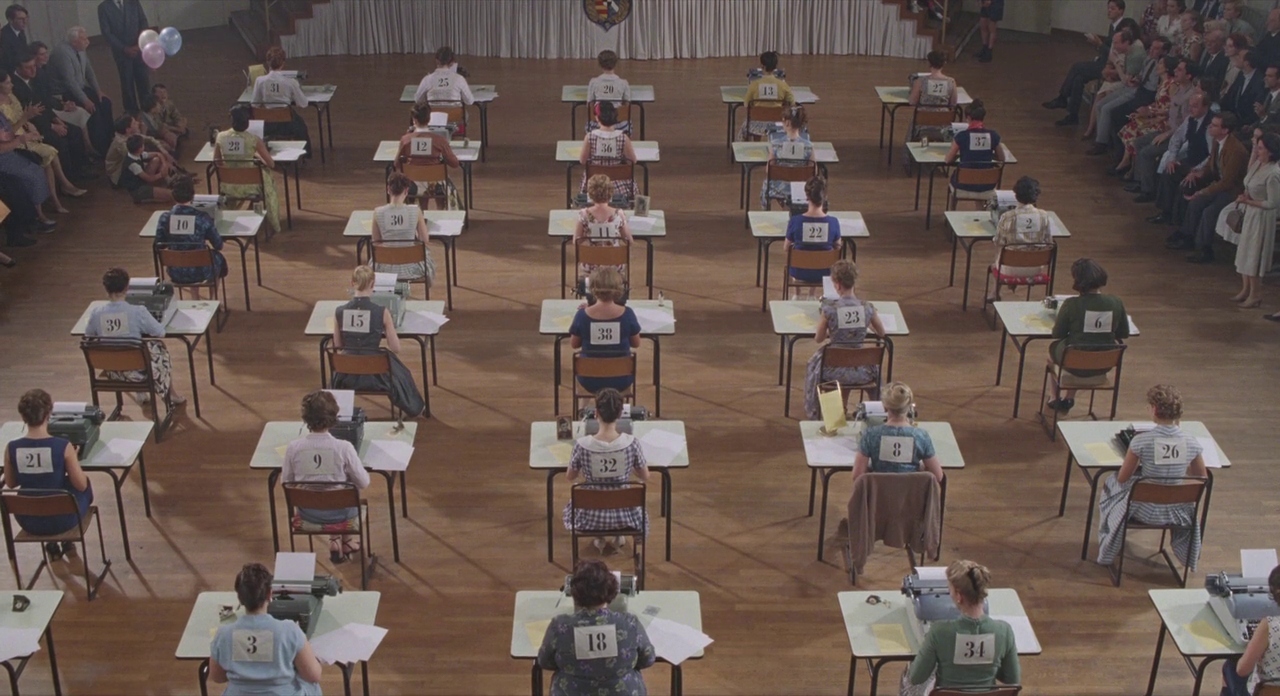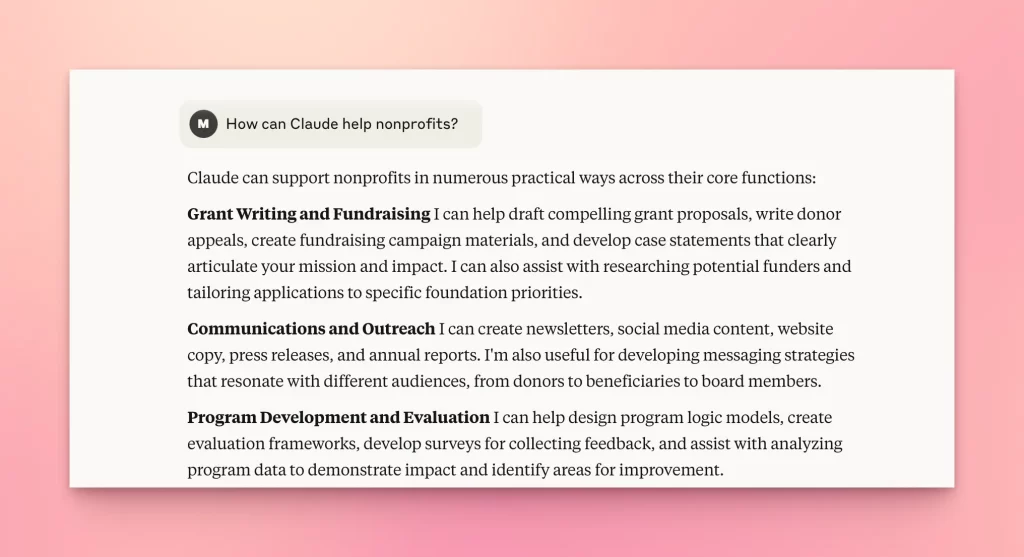More nonprofit leaders are asking: “Is Claude better than ChatGPT for our writing?” Or “Can we afford it – and is it actually safe for donor content?”
This guide delivers the full picture. No fluff. Just clear, updated answers to help you decide if Claude is the right fit, and how to make the most of it if you move forward.

Table of Contents
What Is Claude – and Why Nonprofits Care
Claude is an AI assistant developed by Anthropic, a company founded by ex-OpenAI researchers. It works a lot like ChatGPT: you enter a prompt, and it responds with content, summaries, or answers. But the feel is different – Claude is more conversational, context-aware, and cautious.
For nonprofits, that matters.
Claude is especially good at:
- Understanding nuance in long, complex content (grants, interviews, reports)
- Writing in a thoughtful, professional tone (less robotic)
- “Reading between the lines” when you give it vague or imperfect prompts
It also puts more emphasis on safety than most AI tools. Anthropic’s brand is built around making AI that’s helpful and honest. That means Claude is less likely to produce false, risky, or offensive content – something that matters when you’re handling donor comms or sensitive subject matter.
Claude Models (2025 Overview)
Anthropic currently offers several Claude models tailored to different needs. Here’s how they compare:
- Claude 4.1 Opus
This is Anthropic’s most capable model, used in the Enterprise tier. It supports large-scale reasoning, tool use, data integration, and long content inputs. Ideal for high-stakes writing, research, and complex workflows. - Claude 4 Sonnet
Available in the Claude Pro plan, Sonnet balances speed and reasoning. It delivers thoughtful, clear writing while staying fast enough for day-to-day content tasks. Best for nonprofit comms, email writing, and storytelling. - Claude 3.7 Sonnet
A slightly older model still used in some applications. It blends fast processing with decent comprehension but lacks the newer enhancements in Claude 4. - Claude 3.5 Sonnet
This is the model used in the free tier. It supports up to 200K input tokens and handles basic tasks like summaries, brainstorming, or simple drafts. Good for trying things out, but not ideal for fundraising or campaign content.
For most nonprofit teams, Claude 4 Sonnet or 4.1 Opus is the sweet spot – especially when accuracy, nuance, and integration matter.
Claude Pricing Breakdown
Claude offers three main pricing tiers:
- Claude Instant (Free)
- Access to Claude 3.5 Sonnet
- Handles inputs up to 200K tokens
- Includes basic chat and content generation features
- Best for: testing, exploration, and light individual use
- Claude Pro ($200/year or $20/month)
- Access to Claude 4 Sonnet
- Supports up to 200K tokens per input
- Includes faster response times, longer memory, and priority access
- Best for: solo comms professionals and small nonprofit teams
- Claude Enterprise (starting around $50,000/year)
- Access to Claude 4.1 Opus, Anthropic’s most advanced model
- Input capacity exceeds 200K tokens, with expanded context windows
- Includes admin tools, API integrations, collaboration features
- Best for: larger organizations needing scale, team collaboration, and security
How to Apply for Claude’s Nonprofit Discount
- Visit Anthropic’s main Pricing page and explore their Enterprise or Team tiers.
- Reach out directly via their contact form or support channels to request nonprofit pricing or ask about eligibility. This is currently the most effective way to explore a discounted or customized rate.
- Include a brief note about your organization’s status, mission, and context when reaching out – many companies respond to values-aligned requests even without formal programs.
7 Use Cases with Basic Nonprofit Prompts

1. Interview → Donor Story
“Act as a storytelling writer. I’m pasting an interview transcript with a youth program graduate. Create a first-person narrative, 400-500 words, that begins with a vivid detail, includes two direct quotes, and ends with a soft ask. The tone should be emotional but respectful.”
2. Annual Report Summary
“You’re writing an ED letter for an annual report. Pull 3 key stats from this program summary (pasted), include 1 personal story, and wrap with a forward-looking close. Limit to 300 words. Tone: confident, clear, and warm.”
3. Appeal from Bullet Points
“You are a fundraising copywriter. Based on this year’s stats (listed), write a direct mail letter that highlights our community impact and invites a recurring gift. Use plain language and focus on the donor’s role.”
4. Grant Skeleton
“Write a 5-part outline for a grant proposal focused on education equity. Use these bullet notes. Then generate sample sentences for each section that I can expand into a full draft.”
5. Board Email from Meeting Notes
“Summarize these notes into a 250-word email for the board. Focus on 3 takeaways, include a quote, and list next steps. Tone: professional but not stiff.”
6. Multi-Channel Repurposing
“Turn this blog into: (1) 3 LinkedIn posts (~100 words each), (2) 3 Instagram captions (<250 characters), and (3) 1 email preview. Keep the tone consistent and audience-aware.”
7. Thank-You Template Creation
“Generate a thank-you template for donors who gave $250-$1,000. Make it modular (headline, body, PS), with placeholders. Tone: personal, warm, and aligned with year-end appeals.”
Prompting Tips: How to Get Better Output
Claude responds best when you give it structure. The more direction you provide, the more useful and on-brand the result will be.
Start by setting the role: tell Claude who it’s writing as. For example, “Act as a nonprofit comms manager writing a donor thank-you email.” That single sentence can shift the entire tone and focus.
Next, be specific about your goal. Don’t just say “write an update” – say “write a 300-word email to mid-level donors sharing impact from our March campaign, with a CTA to renew their monthly gift.”
Always provide context. Drop in past writing examples, notes, or campaign results. Claude isn’t magic – it can’t guess what matters most to your audience without some guidance.
If you want a specific format (like email, social post, or grant outline), say so. You can even list out the structure you want: headline, body, CTA, PS.
Finally, ask for edits. If the first draft is too long, too stiff, or not emotional enough – just say so. “Now make it warmer and cut 50 words” works better than “rewrite”.
It’s not about writing the perfect prompt. It’s about talking to Claude like a smart colleague who just needs the right briefing.
Pros, Cons, and Rollout Tips
Pros
- Excellent at understanding long documents
- Safer output defaults (fewer hallucinations or risky tone)
- Deep reasoning and emotional tone matching
Cons
- No team approvals, content versioning, or shared workspaces
- Prompt memory is session-based (no persistent brand training)
- Limited formatting or exports for copy/paste workflows
How to Roll It Out
- Start with Claude Pro
- Collect and save your favorite prompts in a shared document
- Use it for grant writing, summaries, board updates and reporting
Claude for Nonprofits FAQ
Q: Is Claude HIPAA or PII-compliant?
Not officially. Don’t input donor addresses, phone numbers, or payment info. Use de-identified text for testing.
Q: How does Claude compare on data privacy?
Claude doesn’t train on your prompts unless you opt in. This makes it a safer choice than ChatGPT, which default to data collection for free plans.
Q: Can I preload our tone or brand voice?
No. You can paste past writing and ask Claude to mimic the tone – but it won’t remember across chats.
Can Claude handle complex grant proposals or board reports?
Yes – especially with the 4.1 Opus or 4 Sonnet models. Claude is strong at summarizing dense notes, organizing information, and maintaining professional tone. It’s one of the better tools for grant writers and executive comms.
Can Claude create images or videos?
Not yet. Claude is text-only. For image generation, you’ll need to pair it with tools like DALL·E or Canva. If you’re creating full donor campaigns, Claude can draft scripts or captions, but you’ll need another platform to produce visuals.
Claude vs ChatGPT vs Kweet
| Feature | Claude | ChatGPT | Kweet |
|---|---|---|---|
| Long input processing | ✅ Great | ✅ Great | ✅ Great |
| Donor-centric writing | ⚠ No | ⚠ No | ✅ Always aligned with org mission, voice, and comms standards |
| Storytelling tone control | ✅ Natural, careful | ⚠ Often generic | ✅ Tuned for donor engagement |
| Email + social content | ✅ Basic drafts with light context | ✅ Basic drafts with light context | ✅ Donor-centric, mission-aligned |
| Prompt library | ✖ Start from scratch each time | ✖ Start from scratch each time | ✅ Prompt library tailored to fundraising, comms, and campaigns |
| Team collaboration | ✖ None | ✖ None | ✅ Collaborate on the content calendar (edit, approve) |
Final Checklist: Should You Start With Claude?
- You handle complex, long-form content
- You want tone-safe, human-sounding writing
- You’re comfortable testing prompts
- You don’t need team collaboration tools yet
- You want a safer alternative to ChatGPT or Gemini
If most of those are true, Claude is a strong fit – especially the newer Claude 4 Sonnet or Opus 4.1 models.
